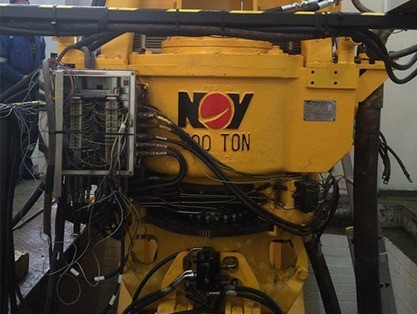MRDS specialise in drilling equipment overhauls, with top drives being the key overhauls undertaken. Our dedicated team of engineers have the extensive OEM experience to service and inspect a range of OEM top drives from companies like MH Wirth, NOV and Canrig. The team can be mobilised worldwide to provide services both on land and offshore, and all visits come complete with detailed reports.
A top drive is a mechanical device on a drilling rig, made up of one or several electric or hydraulic motors which are connected to the drill string via a short pipe called the quill. (The drill string is the length of pipe that goes down in to a well and attaches to the drill bit at the bottom of the hole). Throughout this process, the top drive is suspended from a hook below the travelling block, and is able to move down or up the mast, or derrick, of the drilling rig.
The top drive is used to rotate the drill string during the drilling process. These rotations use at least 1000 horsepower to turn a shaft that the drill string is screwed onto. The top drive can be used as an alternative to the more traditional rotary table or Kelly drive. Using a top drive reduces both the manual labour and the time in drilling, as well as a number of risks.
TOP DRIVE BENEFITS
The use of top drives has improved the drilling industry, making rigs safer and more efficient and allowing targets to be easily reached that were previously difficult.
Using a top drive can lead to a number of safety and efficiency improvements. Amongst the benefits are:
1) Drilling distance
A top drive allows a drilling rig to drill a deeper section of a drill pipe in one operation, as a rotary table rig can only drill 30 feet / 9.1 metre sections. By contrast, a top drive can drill between 60 to 90 feet / 18-27 metres. This ability to deal with longer sections of drill pipe allows a drilling rig fitted with a top drive to make greater progress – up to 90 feet / 27 metres in one go.
2) Drilling time
Top drive systems also are more time efficient. Top drives typically decrease the frequency of stuck drill strings, as the amount of time that a drill string is not rotating (and therefore liable to get stuck) is greatly reduced. All of this contributes to cost savings. Using a top drive enables drillers to engage and disengage the rotary or pumps faster, while restringing or removing the pipe.
Top drives remove a lot of the manual labour that previously was involved in the drilling of wells.
3) Safety
Top drive use will remove many of the potentially dangerous tasks that are performed where rig hands are working. As a top drive allows rigs to add up to three joints of drill pipe at one, compared to a conventional rotary rig where joints must be added one at a time, there are fewer connections required. This in turn mean crews are less exposed to potential injuries.
As top drives have a link tilt system that brings the pipe closer to the rig hand, they do not require to lean out into the mast, as well as enabling the racking of the bottom of the stand on the rig floors easier and safer.

